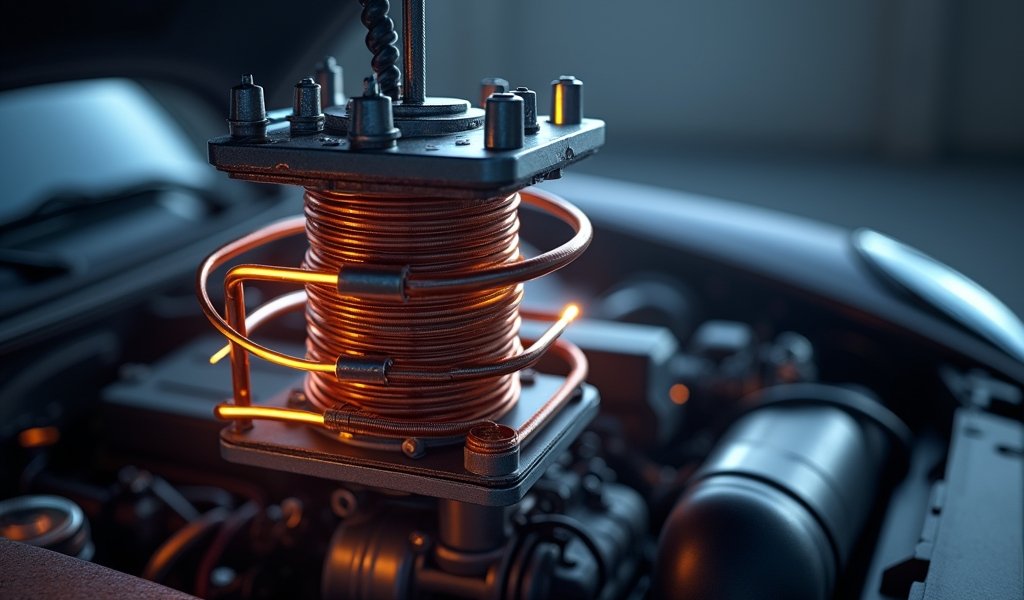Overview
This article explains how ignition coil primary resistance affects vehicle performance, offering five key tips for testing, maintaining, and replacing ignition coils to prevent engine problems. The guide emphasizes that monitoring coil resistance (typically 0.4-2.0 ohms) is essential for preventing issues like misfires, rough idling, and decreased fuel economy, with proper testing requiring a quality digital multimeter and manufacturer specifications.
Table of Contents
- Understanding Ignition Coil Primary Resistance
- Why Primary Resistance Matters
- Measuring Primary Resistance: Step-by-Step Guide
- Tip #1: Regular Testing Prevents Bigger Problems
- Tip #2: Using the Right Tools for Accurate Measurements
- Tip #3: Understanding Manufacturer Specifications
- Tip #4: Recognizing Symptoms of Failing Coils
- Tip #5: Proper Maintenance and Replacement
- Conclusion
- Frequently Asked Questions
Understanding Ignition Coil Primary Resistance
Ignition coil primary resistance is the cornerstone of your vehicle’s spark generation system—the unsung hero that transforms your battery’s low voltage into the powerful spark needed to ignite fuel. Like a silent conductor orchestrating your engine’s performance, these components work tirelessly beneath your hood. When functioning correctly, they remain invisible to the average driver, but when they falter, the symphony of your engine can quickly become a discordant mess.
As a professional mechanic with over 15 years of experience, I’ve seen countless vehicles hobbled by ignition coil issues that could have been prevented with basic knowledge and maintenance. Primary resistance—measured in ohms—tells us how effectively the coil can build the magnetic field necessary for generating spark. Too high or too low, and your engine performance suffers dramatically.
The modern ignition coil operates on principles that haven’t changed much since the early days of automotive engineering, yet many drivers remain unfamiliar with this vital component. Think of it as your engine’s pulse—when it’s strong and steady, everything runs smoothly. When it weakens, your entire vehicle feels the effect.
Why Primary Resistance Matters
Primary resistance isn’t just some obscure specification gathering dust in your vehicle’s manual—it’s the lifeblood of your ignition system. When resistance falls outside the manufacturer’s specifications, it’s like trying to run a marathon with either too-tight or too-loose shoes; neither scenario leads to optimal performance.
Low primary resistance can cause excessive current flow through the ignition module, which, like a river overflowing its banks, can damage electronic components over time. This flood of current generates excess heat, potentially cooking sensitive components that weren’t designed to handle such thermal stress.
Conversely, high resistance acts like a clogged artery, restricting current flow and resulting in weak sparks that struggle to ignite your fuel mixture properly. This can lead to improper spark plug performance, misfires, rough idling, and that dreaded “Check Engine” light illuminating your dashboard like an unwelcome holiday decoration.
According to research from the Society of Automotive Engineers, ignition system failures account for approximately 20% of all vehicle no-start conditions. Many of these could be prevented with proper understanding and maintenance of ignition coil resistance values.

Measuring Primary Resistance: Step-by-Step Guide
Testing ignition coil primary resistance is surprisingly straightforward, requiring only a digital multimeter and a few minutes of your time. Consider it the equivalent of taking your engine’s pulse—a vital sign that can reveal much about its health.
Here’s a simple process to measure primary resistance accurately:
- Disconnect the negative battery terminal for safety
- Locate your vehicle’s ignition coil(s)
- Set your multimeter to read ohms (Ω)
- Connect the multimeter leads to the primary terminals of the coil
- Record the resistance reading
- Compare your reading to manufacturer specifications
The primary resistance typically ranges from 0.4 to 2 ohms, though this varies by manufacturer and coil design. Modern vehicles with computer-controlled ignition systems may have lower resistance values than older vehicles, as they’re designed to work with sophisticated engine management systems that precisely control current flow.
Remember that temperature affects resistance readings—cold coils typically show lower resistance than warm ones. For the most accurate results, take measurements when the engine is at normal operating temperature, but be careful not to burn yourself on hot engine components.
Tip #1: Regular Testing Prevents Bigger Problems
Just as regular medical check-ups can catch health issues before they become serious, routine ignition coil testing can identify potential failures before they leave you stranded. I recommend checking your coil resistance annually or whenever you experience ignition-related symptoms.
This preventive approach can save you from the cascading failures that often follow ignition coil problems. When coils begin to fail, they can damage other components in the process—from knock sensors to catalytic converters, the ripple effects can be extensive and expensive.
Start with a baseline reading when your vehicle is performing well, then compare future measurements against this reference point. Deviations of more than 10% from your baseline or manufacturer specifications warrant further investigation and possible replacement.
Many professional mechanics have witnessed the frustration of drivers who’ve spent hundreds diagnosing complex problems that stemmed from a simple ignition coil issue. Regular testing is like keeping a weather eye on the horizon—you’ll see the storm coming before it hits.
Tip #2: Using the Right Tools for Accurate Measurements
The right tool makes any job easier, and measuring ignition coil resistance is no exception. A quality digital multimeter is worth its weight in gold when diagnosing electrical issues. Analog meters, while nostalgic, simply don’t provide the precision needed for modern vehicles.
When selecting a multimeter, look for these features:
- Auto-ranging capability for easier measurements
- Accuracy of at least ±0.5% for resistance readings
- Backlit display for working in dimly lit areas
- Durable construction that can withstand shop conditions
- Data hold function to capture readings in awkward positions
Proper lead maintenance is also crucial. Corroded or damaged leads can introduce phantom resistance, skewing your readings like a funhouse mirror distorts your reflection. Check your leads regularly for continuity and replace them at the first sign of wear or damage.
According to Fluke, a leading manufacturer of testing equipment, nearly 30% of inaccurate electrical readings stem from poorly maintained test equipment rather than actual component issues.
Tip #3: Understanding Manufacturer Specifications
Manufacturer specifications for ignition coil resistance are like a recipe’s ingredient measurements—deviate too much, and the results won’t be as expected. These specifications aren’t arbitrary; they’re carefully calculated values that ensure optimal performance under various operating conditions.
Your vehicle’s service manual is the definitive source for these specifications, but if you don’t have access to one, reputable online databases like AllData or manufacturer websites can provide the information you need.
Remember that specifications vary widely between vehicle makes, models, and even production years. What’s normal for a Ford might be problematic for a Toyota, much like how dietary requirements differ between individuals.
Most manufacturers provide both a minimum and maximum acceptable resistance range. Readings below the minimum typically indicate a short circuit within the coil, while readings above the maximum suggest a break or high-resistance connection in the primary winding. Either condition necessitates replacement of the coil to restore proper operation.

Tip #4: Recognizing Symptoms of Failing Coils
Ignition coils rarely fail without warning. Like an athlete developing a limp before a major injury, your vehicle will typically display several symptoms that, to the trained eye, scream “check your ignition system!”
Watch for these telltale signs of ignition coil problems:
- Engine misfires, especially under load or acceleration
- Rough idle that feels like sitting on a washing machine
- Decreased fuel economy (your wallet feels the difference)
- Hesitation or stumbling when pressing the accelerator
- Difficulty starting, particularly in damp weather
- Check Engine light illumination with misfire codes (P0300-P0312)
These symptoms often come and go initially, making them easy to dismiss. However, like the first raindrops before a downpour, intermittent symptoms typically precede complete failure. Addressing them early can prevent you from being caught in the storm of a roadside breakdown.
I’ve lost count of how many customers have told me, “It was running fine until suddenly…” only to discover their vehicle had been dropping hints for weeks or months before finally giving up. Learning to read these signs is like understanding the subtle language your car uses to communicate its needs.
Tip #5: Proper Maintenance and Replacement
When it comes time to replace ignition coils, quality matters more than saving a few dollars. Bargain-basement coils are often as reliable as a chocolate teapot—they might look the part, but they won’t perform when the heat is on.
Follow these guidelines for ignition coil maintenance and replacement:
- Use OEM or high-quality aftermarket coils from reputable manufacturers
- Replace coils in complete sets when possible for balanced performance
- Inspect related components like spark plugs and wiring while coils are accessible
- Apply dielectric grease to coil boots to prevent moisture intrusion
- Ensure proper seating and connection of all electrical connectors
- Verify correct resistance values of new coils before installation
Many professional mechanics recommend replacing all coils simultaneously, even if only one has failed. This approach, while initially more expensive, provides balanced ignition performance and prevents the “domino effect” of sequential failures that often occurs when coils of different ages operate together.
Modern coils typically last between 80,000 and 100,000 miles under normal conditions, but factors like driving habits, environmental conditions, and overall vehicle maintenance can significantly impact this lifespan. Consider coil replacement as preventive maintenance around the 80,000-mile mark, especially if you rely heavily on your vehicle.
Conclusion
Understanding ignition coil primary resistance is like having a crystal ball into your engine’s future—it reveals potential issues before they become catastrophic failures. By following the five tips outlined in this guide, you’ll be well-equipped to maintain this crucial component of your vehicle’s ignition system.
Regular testing, using quality tools, understanding specifications, recognizing symptoms, and performing proper maintenance form the foundation of ignition system reliability. Like a well-conducted orchestra, when all these elements work together, the result is a smoothly running engine that performs reliably for thousands of miles.
Remember that your vehicle’s ignition system is the spark that brings mechanical engineering to life—without it, even the most perfectly designed engine is just an expensive paperweight. Taking the time to understand and maintain your ignition coils pays dividends in reliability, performance, and peace of mind.
What ignition system issues have you experienced, and how did you address them? Share your stories and tips in the comments below—your experience might just save a fellow driver from being stranded on a dark, rainy night with a no-start condition and a tow truck bill!
Frequently Asked Questions
What is the normal primary resistance range for most ignition coils?
Most ignition coils have a primary resistance between 0.4 and 2.0 ohms. Always refer to your specific vehicle’s manufacturer specifications for the exact acceptable range.
Can I drive with a failing ignition coil?
While technically possible, driving with a failing coil can damage other components and leave you stranded. It can also cause catalytic converter damage from unburned fuel.
How often should ignition coils be replaced?
Most ignition coils last 80,000-100,000 miles under normal conditions. Consider preventive replacement around this mileage, especially in vehicles you depend on daily.
Will a bad ignition coil always trigger a check engine light?
Not always, especially if the failure is intermittent or minor. Modern vehicles will typically trigger a check engine light when misfires reach a threshold that could damage the catalytic converter.
Can weather conditions affect ignition coil performance?
Yes, extreme temperatures and moisture can affect coil performance. Cold weather makes starting more demanding on coils, while moisture can create short circuits in damaged coil insulation.

